Did you know Eleanor Shakiba is the author of Difficult People Made Easy? Buy your copy of this practical guide to solving people problems today. It makes a great gift for HR and L&D experts who’ve had to deal with conflict this year!

Did you know Eleanor Shakiba is the author of Difficult People Made Easy? Buy your copy of this practical guide to solving people problems today. It makes a great gift for HR and L&D experts who’ve had to deal with conflict this year!
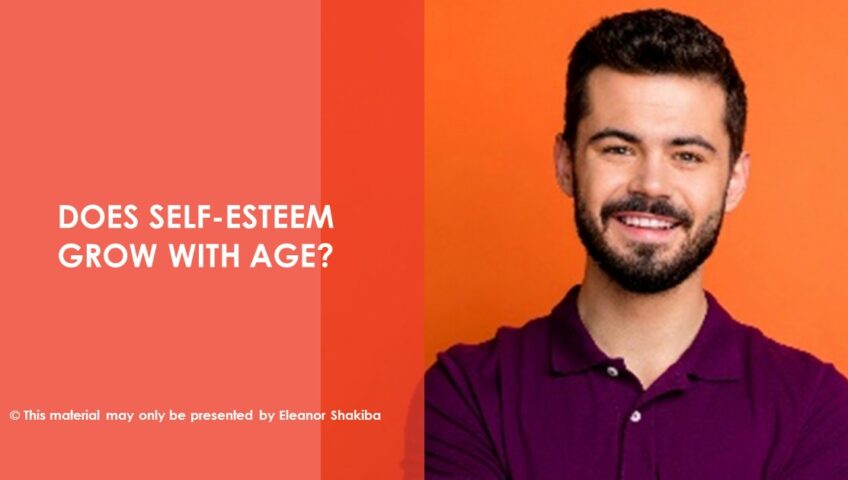
Self-esteem is the value you place on yourself. Having an appropriately high level of self-esteem is important for your mental health and self-agency. In other words, a high level of self-esteem enables you to act towards living a happier and more successful life. If you’re working on your self-esteem, you may be buying into a common myth: that low self-esteem in childhood translates into low self-esteem in adulthood. But is this true?
Thanks to researchers at the University of Bern, we’re now getting closer to answering this question. The research team did a large-scale analysis of studies on self-esteem. They drew together data from 164,868 participants. The results of this study are intriguing. They showed that self-esteem changes in predictable ways over your lifespan. And if you had low self-esteem during childhood, there is some good news. Although self-esteem may drop in middle childhood, it generally rises from there. The peak age for experiencing high levels of self-esteem is between 60 and 70 years. If you’re older than that, though, don’t assume you’re destined to experience poor self-esteem. In fact, the most significant drop in self-esteem occurs after 90 years.
Interestingly, the pattern of self-esteem development seems to be consistent regardless of gender, ethnicity and culture. It is interesting to note that self-esteem levels fluctuate across your lifespan. So let’s take a quick look at the pattern the research has detected.
In early childhood, you didn’t really distinguish between yourself and others. Thus, you were more likely to have stable self-esteem. Between the ages of four and eight, though, you might have experienced a drop in self-esteem. This is probably because you are now able to compare yourself to your peers. Plus, as your cognitive skills developed, you began to understand that who you wanted to be was not necessarily who you really were. This difference between your ideal self and actual self has been shown to significantly impact on self-esteem.
If you had a troubled adolescence, it’s probably not surprising to hear that self-esteem often declines between the ages of 11 and 13. This seems to be because of the stress of identity changes that happen during the transition from childhood to adolescence. However, the Bern study revealed something intriguing. From around 15 years of age, self-esteem is likely to begin recovering.
If you think back to your early 20s, you’re probably realising that your self-esteem gradually began increasing around this time. The University of Bern study showed that a slow and steady increase in self-assurance occurs from this age on. So does the increase ever stop? Apparently, the answer is yes. Self-esteem seems to peak between the ages of 60 and 70. However, that’s not necessarily bad news. At this point it levels out, rather than declining. In fact, self-esteem seems to remain relatively static until the age of 90. Even at this point, decreases are not always large.
Of course, it is always possible to boost your self-esteem. Taking action to do this is constructive if you experience a lot of self-doubt or want to become more confident. If this is the case, remember that there’s lots you can do.
About the author: Eleanor Shakiba
Eleanor is a trainer and coach, with a passion for unleashing the power of positive deviance in talented people. She has taught more than 50,000 people how to excel professionally. An expert in the field of Positive Psychology, Eleanor is also qualified in Social Anthropology, Counselling, Coaching, Adult Education and Neuro Linguistic Programming. She specialises in helping HR and L&D practitioners to unleash the power of positive psychology in business. Her major focus in developing three key areas that support positive workplace cultures: positive mindset, proactive communication and purposeful leadership. Eleanor is the author of the Positive Psychology Toolkit for HR and L&D Practitioners. Download your free copy here.
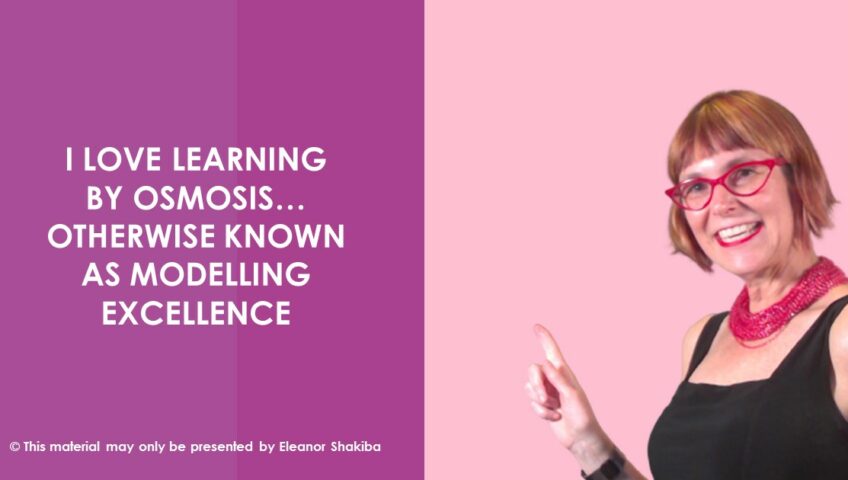
Why should professional facilitators be in coaching themselves? Well, I’m tempted to get on my high horse here. I firmly believe ‘people experts’ face the same challenges as therapists and coaches. Why do I believe this? Because helping others, as facilitators and coaches do, inevitably means dealing with your own ‘stuff’ as well as your clients’ issues. The best practitioners I have met in personal and professional development fields all have regular coaching or counselling themselves.
The bottom line is that professional supervision helps coaches and facilitators to:
There are also a number of personal benefits ‘people experts’ can gain from participating in regular coaching or supervision. Here’s why I attend coaching every month without fail.
As an introvert, I need a structure for reaching out
Introverts are autonomous and self-disciplined. This is often seen as a strength. Like all strengths, though, when taken too far. It can become a limiting characteristic. To me, the downside of being an autonomous practitioner is that I will build my own solutions rather than seeking expert assistance. Having a monthly coaching session prevents me doing this too often. It gives me a forum for talking through tricky decisions or complex situations. I often find that discussing a challenging scenario with my coach leads to faster and more effective solution finding than working solo.
Sometimes I am too creative
Creativity is my signature strength. I love coming up with new ideas. Indeed, it’s impossible to stop myself from doing this. In the early stages of my career, I exhausted myself by trying to action every idea I developed. These days, I work a lot smarter. I keep a list of my brilliant ideas. Then I discuss these with my coach. By the end of our session, I’ve usually discarded most of the ‘shiny things’. Those that are left have been developed into concrete action plans, which become part of my business strategy.
This keeps my creativity working on the important things. It also enables me to switch between creative and practical modes in a way that suits my work style. It has taken me many years to realise that whilst thinking up new ideas is fun, actioning them takes a great deal of energy. It is therefore important to ensure I am spending my energy on the best ideas, rather than trying to do all of them.
I love learning by osmosis… otherwise known as modelling excellence
As an NLP trainer, I am passionate about learning from masterful practitioners. Working with a coach gives me a brilliant opportunity to observe a more experienced practitioner in action. This enriches my own client work, as well as giving me inspiration for reading up on new theories and professional developments.
Overall, I believe that coaches should walk our talk. We tell our clients, “Coaching is a foundation for masterful performance.” Therefore, it makes sense that we should be in coaching ourselves. Have I been true to my word here? Well, last year my coach and I celebrated 20 years of working together. That means I spent more than 200 hours as a coachee myself. Looking back, I can certainly confirm that every hour has contributed to my wellbeing and success.
Eleanor Shakiba is a positive psychology trainer and coach. To find out more about her approach to producing positive results with her clients, download the Positive Psychology Toolkit for HR and L&D Practitioners here. It’s a free resource, in which Eleanor explores the foundation techniques of positive psychology.
About the author: Eleanor Shakiba
Eleanor is a positive psychology trainer and coach. She consults to a range of sectors – including higher education, health, finance and local government. Eleanor has been running training and coaching sessions for people in high intellect professions since 1994. She is qualified in Social Anthropology, Positive Psychology, Counselling, Coaching, Adult Education and Neuro Linguistic Programming. She is also the author of the Positive Psychology Toolkit for HR and L&D Practitioners. This is a free resource for trainers and facilitators.

Did you know you can do online courses with Eleanor? Available 24/7 so you can learn when it suits you. Mini courses cost $55 and full courses are $110 They’re designed for ambitious professionals, who want to accelerate their success. Sound like you? Check your options here.
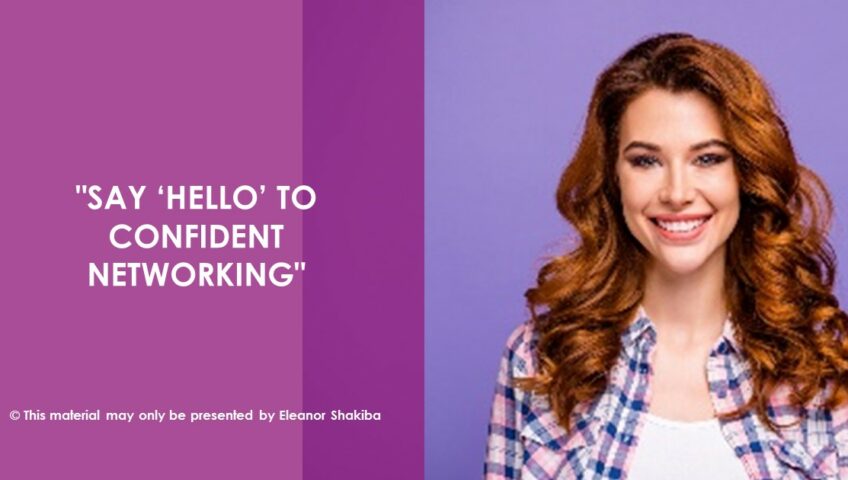
Does the thought of attending a networking event fill you with dread? If so, you’re not alone. Many people find it daunting to connect with total strangers. Even highly confident professionals can find networking a challenge. Key questions participants in my communication skills courses ask about networking include these.
In fact, about half the people in my classes report thinking things like this. So do the maths. That means there is a 50% chance that stranger you’re introducing yourself to is experiencing the same trepidation as you. Fortunately, there are some simple tactics you can use to make both yourself and others more comfortable at professional events. Here are three tips to get you started.
Use your happy voice
Your tone and pace of voice send an immediate message to your counterpart. Using a happy tone of voice is more effective than trying to sound confident when building rapport. That’s probably good news if you’ve ever been given the advice ‘just relax and be confident’. Psychologists have done some interesting research in this area. One experiment involved asking volunteers to record themselves, saying “hello” five different times. First, they recorded their greeting using their normal tone of voice. Next, they took on a happy tone. In the third recording, they shifted into a sad mode. Recording number four was an angry tone. And the final recording was made while the volunteer was in Amy Cuddy’s ‘power pose’. If you’re familiar with Cuddy’s research, you’re probably now predicting that the power pose recording would have been preferred by people listening to the greeting. In fact, this was not the case.
The research participants who listened to the recordings were asked to rate how likeable the speaker was in each version of their recording. Across a range of voices, with differing accents and energy levels, the results were conclusive. Listeners responded most positively to the happy voices. So keep this in mind the next time you’re introducing yourself to someone new.
Use information hooks to start the conversation
You can easily avoid awkward silences by thinking of two or three intriguing questions to use as conversation openers. Examples include:
You’ll notice that all these questions are open questions. This means they encourage the conversation partner to open up. Hopefully, as they speak, you’ll hear something you can tie into. In no time at all, you’ll find the conversation flowing smoothly.
Find ways to help
Networking is about making lasting connections. Being helpful will guarantee this happens. Focus on others’ interests and ambitions. If you feel there are opportunities to help out, make an offer. That’s a great way to create a positive impression, as well as build a bridge to staying in touch.
Remember that positive psychology is a great tool for building constructive relationships. Focus on helping others feel comfortable. You’ll soon discover that this distracts you from your worries about networking. You will become more confident and that will make you appear relaxed and interesting.
About the author: Eleanor Shakiba
Eleanor is a specialist in positive psychology. Her passion is teaching talented people to use social and emotional intelligence to excel in business. These skills centre around building positive mindsets, proactive communication habits and purposeful leadership behaviours. Eleanor’s qualifications include degrees and diplomas in Social Anthropology, Positive Psychology, Counselling, Coaching, Adult Education and Neuro Linguistic Programming. She is also the author of the Positive Psychology Toolkit for HR and L&D Practitioners. This is a free resource for trainers and facilitators.
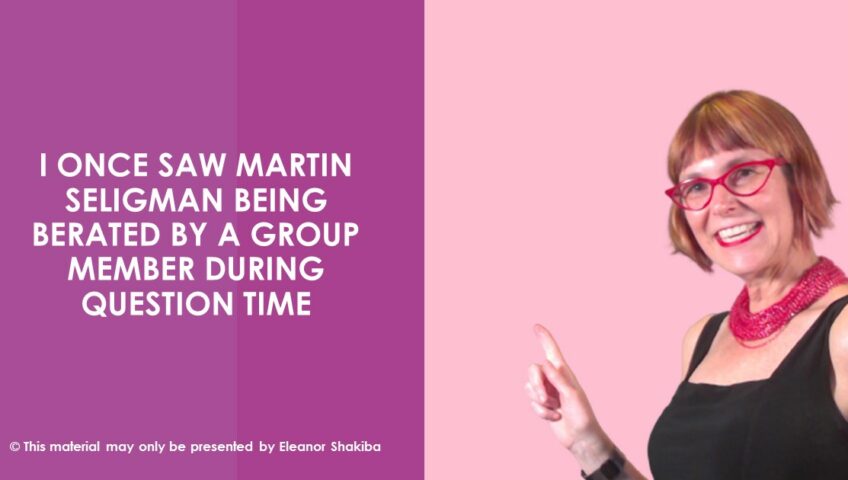
It’s no secret I’m a lifelong learner. When I’m not upfront in the training room, I’m probably learning somewhere else. One of my favourite environments for learning is positive psychology conferences. There, I get to learn from the top minds in my field. Not only that, I get to model their stage skills. This makes the learning experience double layered. Which is why I’m always scribbling frantic notes whenever I’m learning.
Here are my favourite takeaways from the sessions I’ve attended over the years. This article will focus on stage skills, rather than positive psychology content. In a future article, I’ll share insights gained from the expert content delivered by these presenters.
Martin Seligman: the father of positive psychology
I have attended several sessions delivered by Martin Seligman. I am always impressed by his centred, calm presence. His charisma seems to influence everyone in the room. The most notable example of this was the day he arrived unannounced and stood at the back of a training room in Austria. Although the audience was not aware of his presence, there was a notable shift in the group’s energy. When Martin’s presence was acknowledged by the presenter, suddenly the change of atmosphere made total sense.
What have I learned from seeing Martin Seligman in action on stage? Most importantly, I gained insight into the power of grounded and respectful responding. This is a particularly useful skill when you’re facing a heckler or angry group participant. I once saw Martin Seligman being berated by a group member during question time. Her argument was that positive psychology was exploitative and dangerous. She was certainly passionate in her delivery, gesturing wildly and using very strong language. Martin Seligman stood directly in front of her, calmly acknowledging her statements. He was respectful and attentive, whilst also moving the conversation to a more constructive place. A masterful response.
Barbara Fredrickson: expert on positive emotions
Unfortunately, I haven’t yet seen Barbara Fredrickson live, because Covid19 led to conference cancellations in 2020. However, I did attend some online sessions, which she led masterfully. Her presentation was well structured and supported by simple, yet engaging, slides. What really stood out, though, was Barbara Fredrickson’s use of simple metaphors to build a theme through her presentation.
As an NLP trainer, these days, I tend to construct elaborate metaphors which feature intricate plots and characterisations. What I loved about Barbara Fredrickson’s metaphors, in contrast, was they were very simple. For example, she used a metaphor of eating a balanced diet to explain the role of different types of emotions in our lives. This made her point very clear. It also provided a reference point she could return to throughout the presentation. Since observing this pared back metaphor use, I started experimenting with it myself. What I found, is that more concrete learners prefer this style of metaphor. Intuitive ones, on the other hand, are engaged more by the complex NLP style metaphors.
Robert Biswas-Diener: positive coaching expert
I’ve seen Robert Biswas-Diener both online and on stage. He’s a superb presenter. His sessions are humorous, engaging and vibrant. I always learn a new stagecraft trick when I attend his sessions. So what’s the most important technique I’ve gleaned from him? It’s definitely Robert Biswas-Diener’s use of personal anecdotes to establish his authority and connect with his audience. Whether he’s talking about learning to paint or going through tribal scarification rituals in Africa, his stories entertain and embed key presentation messages at the same time.
What gave I learned from all this role modelling? It all boils down to one key message. Expressing your authentic self brings a presentation to life. Audiences don’t want facts, figures and data alone. What makes information resonate is the performance skills of the speaker. And the great news is that these can always continue being developed. So lifelong learners like me will always have something more to learn.
If you, too, are a facilitator or presenter who wants to be masterful in your stage skills, subscribe to my Positive Psychology Toolkit for HR and L&D Practitioners. This gives you access to fortnightly tips on improving both your professional expertise and your stage skills. Download it for free here.
About the author: Eleanor Shakiba
Eleanor is a specialist in positive psychology training. Her core strength is creativity, which she expresses in the training room through storytelling and visual design. She has dedicated her career to helping experienced professionals break through glass ceilings by developing their confidence, communication skills and leadership mastery. Eleanor is qualified in a range of fields including Social Anthropology, Positive Psychology, Counselling, Coaching, Adult Education and Neuro Linguistic Programming. She is also the author of the Positive Psychology Toolkit for HR and L&D Practitioners. This is a free resource for trainers and facilitators.
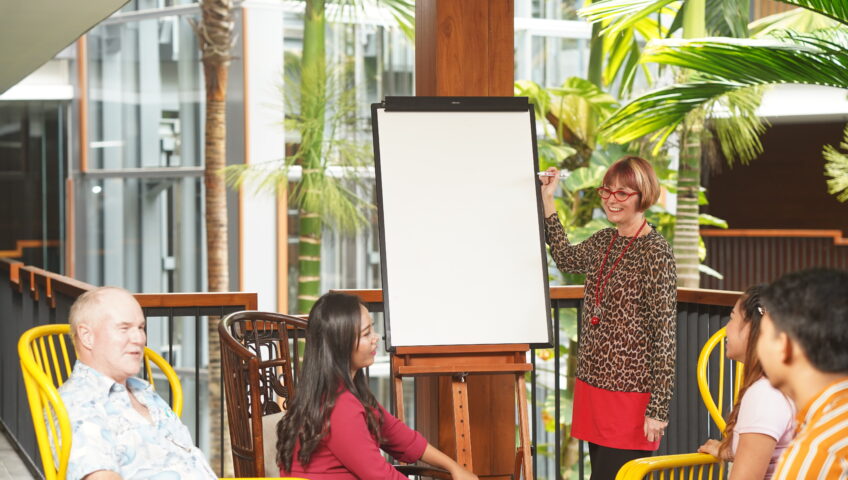
Did you know Eleanor Shakiba runs retreats for trainers and course creators? We’ve moved them from Bali to NSW this year, because of Covid19. Join a group of like-minded professionals as you master the art of crafting teaching metaphors, building resilience and using tools from Positive Psychology to design cutting-edge programs. Find out more here.
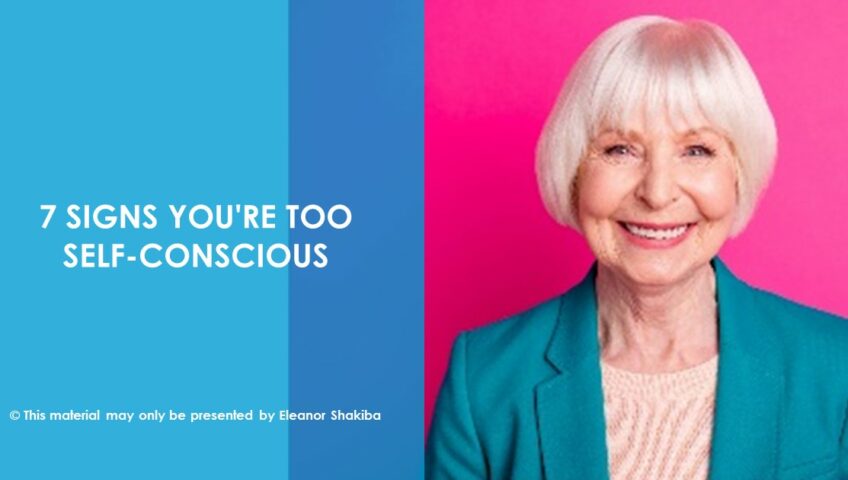
If you think self-consciousness is a problem, think again. It is a unique human ability! Indeed, psychologists say self-awareness is a defining characteristic that separates humans from other species. It is a valuable capability. However, when you begin thinking about your ‘self’ too much, you can become self-conscious. This is a distressing state, in which you ruminate about how others see you. It feels uncomfortable and diminishes your sense of personal power and confidence. Here is a quick checklist to help you assess the extent to which you are overly self-conscious.
You feel awkward and ill at ease around strangers
You’re always worried about what people think of you
You backpedal in conversations or don’t share your opinions to avoid conflict
You feel like you always have to be ‘on’
You second-guess yourself often
You zero in on your perceived imperfections
You have negative body language or bad posture
Fortunately, there are practical steps you can take to overcome self-consciousness. The trick is to redirect your attention outwards or into an activity. In other words, stop ruminating and start doing something else. Options to consider include:
Keep in mind that a little bit of self-consciousness is useful. It helps you behave appropriately, act towards goals and learn from mistakes. Just don’t let it turn into rumination or self-criticism. If you need more tips on how to keep your self-awareness in positive mode, come along to one of my free webinars.
About the author: Eleanor Shakiba
Eleanor is a well-known Australian trainer and coach. She’s passionate about creating vibrant workplace cultures where ‘positive deviants’ can thrive. She does this by partnering with HR and L&D teams to present bespoke training and development programs. Eleanor is qualified in Social Anthropology, Positive Psychology, Counselling, Coaching, Adult Education and Neuro Linguistic Programming. She also runs annual retreats for trainers and facilitators. Download a copy of Eleanor’s free ebook Positive Psychology Toolkit for HR and L&D Practitioners.
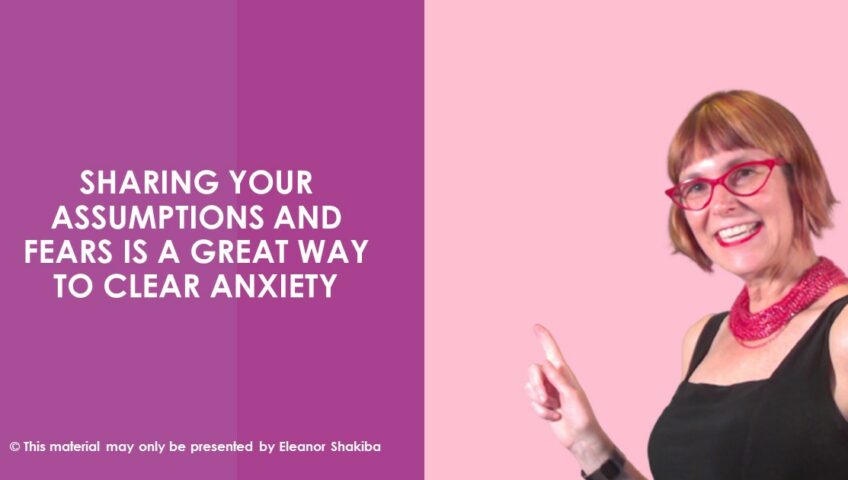
Ouch. Breaking my wrist wasn’t fun. Double ouch. Six months later, I found out the accident had triggered a genetic hand condition called Dupuytren’s disease. This is a progressive and potentially disabling condition which can cause the fingers to contract and stay permanently bent in. Coming to terms with this disease and its possible implications has been a test of my resilience. However, it’s also been a huge learning curve. Here are some of the most important things I’ve learned whilst investigating treatments and choosing the best advisers.
View yourself as a consumer, not a patient
Since my diagnosis, I joined a number of support groups for people with Dupuytren’s disease. As a resilience and assertiveness trainer, this has been a fascinating experience. I’ve been surprised by the number of people who view themselves as being at the mercy of surgeons’ decisions. Indeed, I was so struck by the impact this can have on patient wellbeing, I created a set of four videos on assertiveness and resilience for Dupuytren’s patients. I truly believe that finding the right treatment involves an individual asking assertive questions and getting honest responses from their medical advisors.
The best consultants really do…consult
In my interviews with potential hand surgeons, I noticed a common theme. The doctors at the top of their field had outstanding communication skills. This isn’t really surprising, as research has demonstrated a clear link between professional success and emotional intelligence. What really struck me was that the best surgeons treated me as an equal and positioned our conversation as a consultation. The less skilled surgeons took an authority stance and lectured me on the best course of action from their perspective.
You don’t look stupid if you ask high quality questions
My discussion with other Dupuytren’s patients has frequently revealed that people hesitate to ask questions of their doctors. Why is this? They’re scared of looking stupid, because they lack subject matter expertise. Well, I don’t let that hold me back. After all, you can’t expect to be an expert in everything. I found the best surgeons were very willing to answer my questions. And they even became more ‘human’ when I prefixed these with a quick disclaimer. I simply pointed out that I like to have a fuller understanding of my situation before choosing a treatment. I was therefore going to ask questions that probably seemed basic to them.
Sharing your assumptions and fears is a great way to clear anxiety
Okay. I’m a positive psychology trainer. However, my natural bent for pessimism and catastrophic thinking means I can easily become anxious. My creativity makes things worse, because it enables me to construct outrageously scary scenarios about what might go wrong. I’ve learned that the easiest way to put these aside, is to share them with the experts. Doing this elicits extra information, which allows me to think more constructively. This is such a useful technique. It’s a firm foundation for many of the skills I teach in my Dupuytren’s resilience training program.
Decisions do not stand alone, they’re part of a decision pathway
When you’re diagnosed with a significant condition, it’s easy to assume your first treatment will be the last. However, the progressive nature of Dupuytren’s disease means patients are wise to shift this mindset. The most resilience Dupuytren’s patients I’ve talked with see their treatment choices as a series of linked decisions. I’ve noticed that people who are skilled in rational thinking tend to naturally see their situation this way. Others need to learn the basics of critical thinking and decision-making in order to feel confident in their choices.
Overall, it’s possible to learn from any life event. I definitely wouldn’t choose to have this disease, but now it’s been triggered, I am committed to using my positive psychology skills to help both myself and others in the Dupuytren’s community.
If you’d like more information about how to use positive psychology, download my Positive Psychology Toolkit for free here.
About the author: Eleanor Shakiba
Eleanor is a positive psychology trainer and coach. She works with ‘positive deviants’ to build positive mindsets, proactive communication and purposeful leadership. Since 1994, Eleanor has been teaching talented people how to think, communicate and behave in ways that build success. She holds qualifications in Social Anthropology, Positive Psychology, Counselling, Coaching, Adult Education and Neuro Linguistic Programming. She’s known for her dynamic training style and passion for experiential learning techniques. Download a copy of Eleanor’s free ebook Positive Psychology Toolkit for HR and L&D Practitioners.
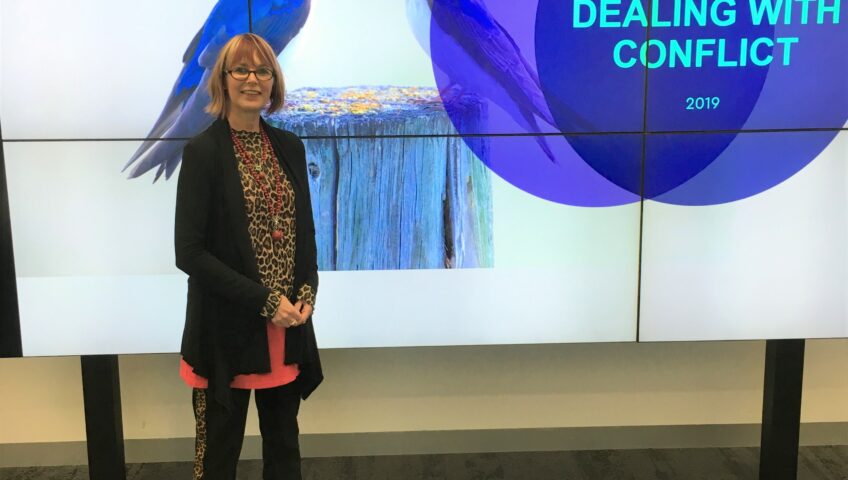
Did you know Eleanor Shakiba can run training at your workplace? Courses are custom designed to meet the needs of your team. Choose from topics such as positive psychology, leadership, breakthrough communication and dealing with difficult people. Find out more here.